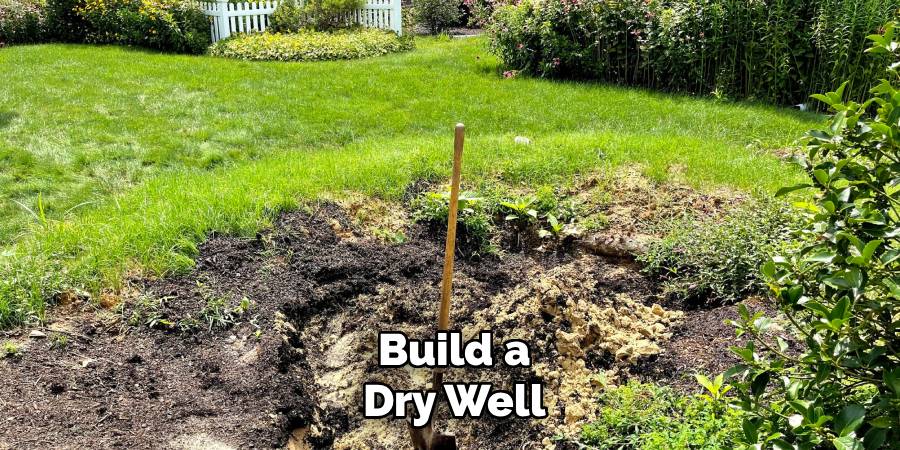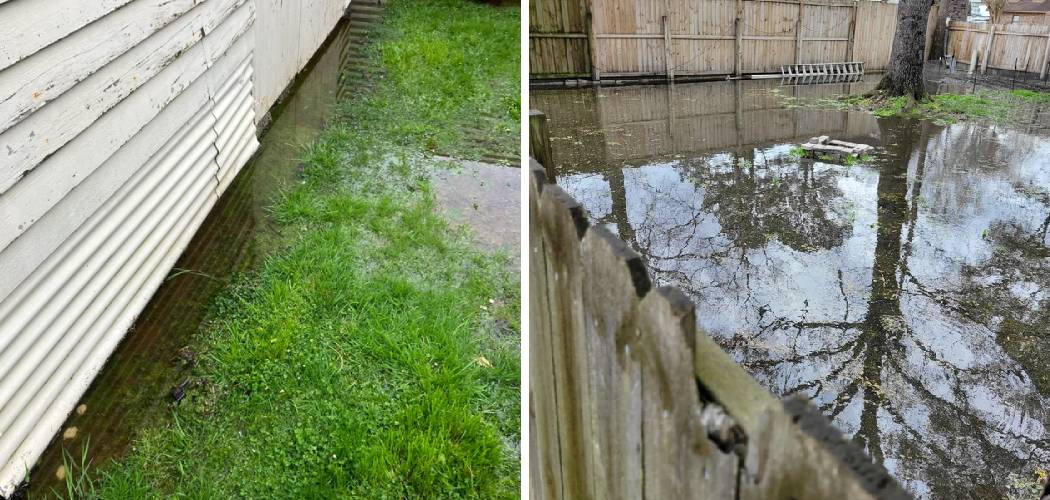A waterlogged backyard is more than just an inconvenience; it can damage your lawn, create a breeding ground for mosquitoes, and even compromise your home’s foundation. Whether you’re dealing with a swampy patch after every rainstorm or widespread standing water, finding a solution is crucial for the health and usability of your outdoor space. The good news is that there are many effective, manageable solutions to this common problem. This guide is designed to provide clear, beginner-friendly strategies and show you how to fix a flooded backyard, helping you diagnose the cause and implement the right drainage solution for your property.

Excess water in your backyard can create numerous challenges, from damaging your lawn to attracting pests and even threatening the structural integrity of your home. Addressing these issues early not only prevents further complications but also helps you reclaim your outdoor space for relaxation and enjoyment. By understanding the root causes of flooding and exploring simple, practical fixes, you can transform a soggy yard into a dry, functional area that enhances your property.
Why Does Backyard Flooding Happen?
Backyard flooding can occur for several reasons, often tied to how water flows and drains in the environment. Poor drainage systems, compacted soil, or a lack of proper grading can lead to water pooling in low areas. Heavy rainfall or melting snow can overwhelm the natural ability of the ground to absorb water, especially in areas with clay-rich soil. Additionally, blocked gutters or downspouts can direct water improperly, adding to the problem. Understanding why flooding happens is the first step toward preventing it and protecting your outdoor space.
Tools and Materials
Having the right tools and materials is essential for effectively managing drainage and preventing flooding in your outdoor space. Some common tools you may need include a shovel, a rake, and a wheelbarrow for digging and leveling the ground. Perforated pipes and gravel are often used to create French drains, while gutters, downspouts, and splash blocks help to redirect water away from your home. For soil improvement, materials like sand or organic matter can enhance drainage in compacted or clay-rich areas. Additionally, installing rain barrels or utilizing water diverters can help collect and manage excess water more sustainably. Each of these tools and materials plays a critical role in tackling drainage challenges and maintaining a healthy landscape.
7 Step-by-Step Guide on How to Fix a Flooded Backyard
Step 1: Assess the Source
Before you can fix the problem, you need to understand it. After the next heavy rain, observe your yard carefully. Identify where the water is coming from and where it collects. Is the flooding concentrated in one low spot, or is it a widespread issue? Look at your downspouts. Are they discharging water too close to your house, contributing to the problem? Note the slope of your yard. Water should naturally flow away from your foundation. Understanding these patterns is the first step in diagnosing the root cause and choosing the most effective solution for your specific situation.

Step 2: Check and Clean Gutters and Downspouts
Often, the simplest solution is the most effective. Clogged gutters and improperly aimed downspouts are a primary cause of backyard flooding. When gutters are full of leaves and debris, rainwater overflows and pools directly against your foundation. First, clean your gutters thoroughly. Then, examine your downspouts. They should extend at least four to six feet away from your home’s foundation. If they are too short, purchase downspout extenders. This easy and inexpensive fix redirects rainwater away from your house and into areas of your yard that can better handle the moisture.
Step 3: Improve Your Soil’s Health
Compacted soil is a major contributor to poor drainage. When soil particles are pressed tightly together, there is no space for water to penetrate, causing it to pool on the surface. Lawn aeration is the process of creating small holes in the soil to alleviate compaction. You can rent a core aerator from a local garden center or use a simpler manual tool. Aerating allows water, air, and nutrients to reach the roots of your grass. Following up by spreading a layer of compost over the aerated lawn will further improve soil structure and its ability to absorb water.
Step 4: Regrade the Problem Area
If water consistently pools in a specific low spot or near your house, you may have a grading issue. The ground around your home should slope away from the foundation, dropping about two to three inches for every ten feet. To fix a minor low spot, you can add high-quality topsoil mixed with compost to the sunken area, building it up so it is level with or slightly higher than the surrounding yard. For more significant grading problems, you may need to bring in more soil and use a rake and shovel to create a gentle, consistent slope that directs water away.

Step 5: Install a French Drain
For more persistent drainage problems, a French drain is an excellent and highly effective solution. A French drain is essentially a gravel-filled trench that contains a perforated pipe. It works by collecting surface water and groundwater and redirecting it to a suitable outlet, like a storm drain or a dry well. You begin by digging a trench that slopes downhill, away from the flooded area. You then line the trench with landscape fabric, add a layer of gravel, place the perforated pipe, and cover it with more gravel before folding the fabric over and covering it with soil.
Step 6: Create a Rain Garden
A rain garden is a beautiful and eco-friendly way to manage excess water. It is a shallow depression planted with water-loving native plants and flowers. Rain gardens are strategically placed to collect runoff from your roof, driveway, or lawn. The garden is designed with layers of soil, sand, and gravel that help filter the water and allow it to slowly absorb into the ground, rather than overwhelming your yard. This not only solves a drainage problem but also creates a lovely landscape feature that provides a habitat for pollinators like bees and butterflies.
Step 7: Build a Dry Well
A dry well is an underground structure that disposes of unwanted water by dissipating it into the ground. It is essentially a large hole filled with gravel or a pre-made plastic basin. You can direct water from French drains or downspouts into the dry well. The water collects in the well and then slowly seeps into the surrounding subsoil. This is a great solution for properties that do not have an easy place to discharge water, such as a street or storm drain. It keeps the excess water contained and manages it on-site.

Professional Help Benefits
Seeking professional help for installing a dry well provides numerous benefits. Experts have the experience and knowledge to assess your property’s specific drainage needs and determine the best location and size for the dry well. They can ensure proper installation, which includes excavating the site, using appropriate materials, and ensuring compliance with local building codes or regulations. Professional installers also have access to specialized tools and equipment, which results in a more efficient and reliable system. Additionally, hiring professionals can save you time and effort while ensuring the longevity and effectiveness of the dry well in managing excess water.
Frequently Asked Questions (FAQ)
What Are the First Signs of a Drainage Problem in a Yard?
The most obvious sign is standing water that remains for more than 24 hours after a moderate rainfall. Other signs include:
- A perpetually squishy or soggy lawn.
- Bare patches where grass won’t grow.
- An abundance of moss, which thrives in damp conditions.
- Water pooling near your home’s foundation.
- Noticeable soil erosion or runoff trails.
Will Planting Trees Help with a Flooded Yard?
Yes, planting trees and shrubs can definitely help. Trees absorb a significant amount of water from the soil through their root systems. Species that are known for being particularly “thirsty,” such as willows, river birches, and red maples, are excellent choices for soggy areas. Their roots also help to break up compacted soil, which further improves water absorption and overall drainage in the long term.
What Is a French Drain and Is It a DIY Project?
A French drain is a trench filled with gravel and a perforated pipe that redirects surface and groundwater away from a problem area. It is absolutely a manageable DIY project for a homeowner with basic landscaping skills. It requires significant digging, but the materials are readily available at home improvement stores. The key is to ensure the trench has a consistent downward slope (about a 1% grade) so gravity can do the work.

How Can I Tell if My Soil Is Compacted?
A simple way to test for soil compaction is the “screwdriver test.” Try to push a screwdriver into your lawn’s soil. If it goes in easily, your soil is likely in good shape. If you meet significant resistance and have to force it in, your soil is probably compacted. Another sign is water that pools on the surface and takes a very long time to soak in after watering.
When Should I Call a Professional for Help?
While many drainage issues can be solved with DIY methods, it’s time to call a professional landscape contractor or drainage specialist if:
- The flooding is severe and threatens to enter your home or damage your foundation.
- You have tried several DIY solutions without success.
- The project requires extensive regrading of your entire property.
- You suspect the issue is related to a high water table or a broken underground pipe.
Conclusion
A flooded backyard can feel like an overwhelming problem, but solving it is well within your reach. The solution begins with careful observation to understand why and where the water is collecting. From simple fixes like cleaning your gutters and aerating your lawn to more involved projects like installing a French drain or a rain garden, there is a strategy for every situation. By taking a methodical approach, you can effectively manage excess water and transform your soggy yard back into a healthy, usable space. Now that you know how to fix a flooded backyard, you can confidently take the first step toward reclaiming your outdoor oasis.
About
Jovie Mathews is a distinguished figure in the world of Diy design, with a decade of expertise creating innovative and sustainable Diy solutions. His professional focus lies in merging traditional craftsmanship with modern manufacturing techniques, fostering designs that are both practical and environmentally conscious. As the author of diy, Jovie Mathews delves into the art and science of garden-making, inspiring artisans and industry professionals alike.
Education RMIT University
(Melbourne, Australia) Associate Degree in Design (Jovie Mathews) Focus on sustainable design, industry-driven projects, and practical craftsmanship. Gained hands-on experience with traditional and digital manufacturing tools, such as CAD and CNC software.
Nottingham Trent University
(United Kingdom) Bachelor’s in backyardik.com and Product Design (Honors) Specialized in product design with a focus on blending creativity with production techniques. Participated in industry projects, working with companies like John Lewis and Vitsoe to gain real-world insights.
Publications and Impact
In diy, Jovie Mathews his insights on indoor design processes, materials, and strategies for efficient production. His writing bridges the gap between artisan knowledge and modern industry needs, making it a must-read for both budding designers and seasoned professionals.

